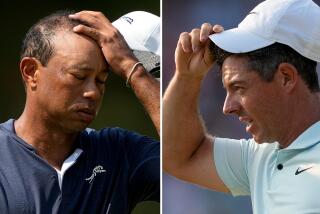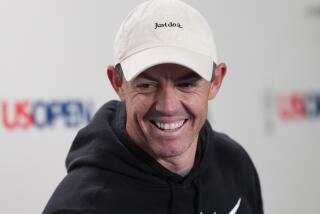Norman Feels Younger All the Time : Golf: Australian was encouraged by Irwin’s U.S. Open victory. That means he has plenty of time to achieve his ‘destiny.’
- Share via
As Hale Irwin’s playing partner in the recent U.S. Open, Greg Norman was standing on the green when Irwin sank a 45-foot putt on the 72nd hole to put him in a playoff for the championship.
Irwin went on to win the tournament in a 19-hole playoff with Mike Donald and put an asterisk next to his accomplishment. At 45, he became the oldest winner of the Open.
Not only was Irwin’s victory an elixir for middle-aged athletes everywhere--much like Nolan Ryan’s sixth no-hitter at the age of 43--it rearranged some priorities for others.
“You’re only as old as you want to be,” said the 35-year-old Norman. “It gets back to desire.
“That Sunday night at the Open, my wife nudged me in the ribs and said, ‘He’s 45, you’ve got 10 more years to go.’
“I said, ‘Thanks a lot.’
“But she’s right. Raymond Floyd won the Open at the age of 43. Jack Nicklaus won the Masters at 46. If you keep your mind and body healthy and you still love to play the game, why can’t you win at 60?
“Hale’s win has encouraged a lot of people. It was great for the game of golf that a guy 45 years of age won the U.S. Open.”
In Norman’s view, Irwin’s 45-foot putt that went over a mound and then broke five feet into the hole was more destiny than luck.
“When those sort of things happen, when a shot hits a tree and bounces back into the fairway and you make a birdie when you should have made a double bogey, that’s destiny,” Norman said.
Norman should know, considering the times he has been victimized by “destiny.”
There was Larry Mize’s 140-foot chip shot that beat him in a playoff in the 1987 Masters, and Bob Tway holed a sand wedge to deprive him of a victory in the 1986 PGA Championship.
There was also his improbable tee shot of 320 yards that landed in a pot bunker in last year’s British Open on the fourth playoff hole that did him in as Mark Calcavecchia went on to win.
Norman is philosophical about such setbacks.
“Destiny has been looking after a few other guys,” he said. “My turn is coming. That’s the way you approach it. I give it my best shot. I bet there are a lot of guys in the world who wish they were in my position to even get beaten.
“I want to do the best I can in every tournament. If someone beats me, so be it.
“You’ve only seen what happens in America, or the British Open. It has happened a lot more overseas. I’ve played in Australia where a guy holes a seven-iron to beat me.
“When I played in Europe while growing up, same thing. Some guy holes a bunker shot. It’s water off a duck’s back.”
Norman made his comments in Thousand Oaks, where he will be the host of the Ronald McDonald Children’s Charities Invitational Nov. 13-18 at the Sherwood Country Club.
It’s a team format with the field consisting of the game’s top money winners, career, or this year.
Norman has already earned $832,709 as the leader on the money list in 1990 and he has played in only 11 tournaments.
“Back in the old days, I’d have to work for four years to make $800,000 on the tour,” Norman said. “Now I can do it in 44 rounds of golf. I’m loving it because we’re in the right place at the right time.”
The purses keep escalating each year and there is apparently no trouble finding sponsors for tour events.
Norman estimates that he can earn $2 million on the tour this year, which would be a record. Tom Kite earned $1,395,278 in 1989, breaking the previous mark of $1,147,644 set by Curtis Strange in 1988--and so it goes. The season-ending Nabisco championships rewarded Kite with $625,000. Yes, that’s just one tournament.
“That’s mind-boggling,” Norman said, recalling that when he was an assistant pro at a golf club, he earned only $28 a week. Now $2 million for a season is a an obtainable goal.
That figure doesn’t even include earnings from foreign tournaments, endorsements and other endeavors.
“A guy can make $400,000, or $500,000 in 10 tournaments, which is only a half-year’s work,” Norman said. “Then he might say, ‘I’ll take six weeks or two months off and not kill myself.’
“When I came over here (from Australia) in the late 1970s, I was intimidated by the American players--the Nicklauses, Watsons, Weiskopfs and Trevinos.
“They grew up on the old exempt tour, the tough way. If you didn’t make the cut, you didn’t play the next week. That breeds inner strength. There is no intimidation factor now.”
With all the money to be earned nowadays by just finishing in the top 10 in any tournament, Norman still wants to win.
“Hunger breeds desire,” he said. “Your desire to do whatever you want to do in the game tells you what direction you want to go. If your desire is to win and keep your game strong for another 10 or 15 years, you’ll do that. But if your desire is just to make money, that will die kind of quickly. It’s just a matter of how you prioritize.
“Money is great, no question about it. It gives you the spoils of life. At the same time you have to work hard. However hard you work, there is some young kid out there working just as hard, if not harder.”
Despite his acknowledged skill, Norman has won only one major tournament, the 1986 British Open.
He’ll try to win it again July 19-22 at St. Andrews in Scotland. And he has been established as the early favorite.
“From an international standard, I think it’s the top tournament in the world,” Norman said. “The sad part about the U.S. Open is that they don’t open it up enough from an international point of view.”
Even if Norman doesn’t win the British Open, or any other major the next few years, he has time on his side.
Irwin proved that there isn’t an age barrier to winning the U.S. Open and Norman’s wife reminded her husband that, after all, he’s only 35.
More to Read
Go beyond the scoreboard
Get the latest on L.A.'s teams in the daily Sports Report newsletter.
You may occasionally receive promotional content from the Los Angeles Times.










